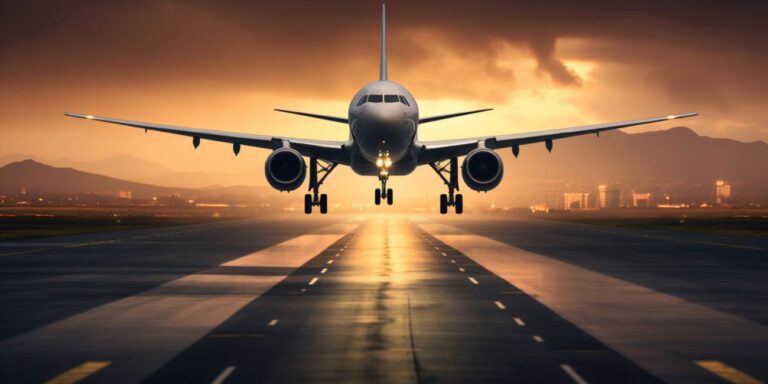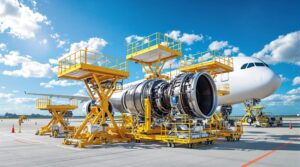The generation of lift is intricately tied to the aerodynamics of an aircraft. At its core, lift results from the interaction between the aircraft’s wings and the surrounding air. The key player in this aero-dance is the wing profile, known as an airfoil.
Imagine the wing as a skilled performer, slicing through the air with finesse. The upper surface of the airfoil is curved, while the lower surface is relatively flat. This distinctive design creates a pressure difference that is the linchpin for lift.
As the aircraft moves forward, the air encounters the airfoil, parting ways as some air flows over the curved upper surface, and some underneath the flat lower surface. Here’s where the magic happens – the air above the wing has to cover a greater distance in the same amount of time as the air below. This results in faster airflow over the upper surface, leading to lower pressure compared to the bottom.
Now, let’s delve into the physics behind this phenomenon. The Bernoulli’s principle steps into the spotlight, stating that as the air velocity increases, its pressure decreases. This creates a suction-like effect on the top of the wing, effectively pulling the aircraft upwards. It’s this suction, coupled with the lower pressure on the upper surface, that forms the lift force, lifting the aircraft skyward.
To illustrate this concept more tangibly, consider an airplane wing as a teeter-totter. The heavier side represents higher air pressure beneath the wing, while the lighter side embodies the lower air pressure above. The result? An uplifting experience for the aircraft – quite literally.
Quantifying lift involves considering several factors, including the wing’s shape, angle of attack, and the speed at which the aircraft is cruising through the air. Engineers meticulously design wings to optimize these variables, ensuring the aircraft can achieve and maintain the desired altitude efficiently.
It’s crucial to note that lift in aircraft isn’t a one-size-fits-all concept. Different types of aircraft, from sleek fighter jets to lumbering cargo planes, boast unique wing designs tailored to their specific operational needs. Variations in wing shapes, sizes, and configurations allow these flying marvels to navigate the skies with distinctiveness.
How do wings generate aircraft lift
Ever wondered how the marvel of flight is achieved? The key to soaring through the skies lies in the intricate design and functionality of aircraft wings. The process by which wings generate lift is a fascinating dance of physics and engineering.
At the heart of this phenomenon is the concept of airfoil shape. Aircraft wings are meticulously crafted with a specific curvature that resembles the shape of an airfoil. This design is not arbitrary; it is the result of careful consideration of aerodynamic principles. The upper surface of the wing is curved while the lower surface is relatively flat, creating a pressure difference that propels the aircraft upwards.
The magic happens when the aircraft is in motion. As it moves forward, the air encounters the wing’s surface. The air above the wing has to cover a greater distance in the same amount of time as the air beneath the wing. According to the Bernoulli’s principle, the faster-moving air generates lower pressure, creating an upward force known as lift.
Adding to this aerodynamic marvel are the wing flaps. These are movable sections at the rear edge of the wing that can be adjusted during different phases of flight. By altering the shape of the wing, pilots can enhance lift or reduce drag as needed. It’s like adjusting the sails on a ship to catch the optimal amount of wind.
But lift generation isn’t solely reliant on the airfoil shape and wing flaps. The angle of attack is another critical factor. This angle, formed between the chord line of the wing and the oncoming air, determines the efficiency of lift production. Pilots carefully control the angle of attack to ensure the aircraft maintains stable flight.
Now, let’s delve into the nitty-gritty of lift distribution. The concept of aspect ratio plays a vital role. Aspect ratio is the ratio of the wingspan to the mean chord (width) of the wing. Wings with a higher aspect ratio tend to have lower induced drag, optimizing lift production. This is why long, slender wings are a common sight on gliders and high-performance aircraft.
As we navigate through the intricacies of wing design, it’s crucial to acknowledge the influence of wing loading. This term refers to the weight supported by each unit of wing area. Higher wing loading can result in faster flight speeds but requires more power for takeoff and landing.
What factors affect an aircraft’s lift
Understanding the dynamics of flight involves delving into the intricacies of airspeed, wing area, and air density. These factors are fundamental in determining how an aircraft maneuvers through the ever-changing medium of air.
Let’s begin with the concept of airspeed. This crucial parameter refers to the speed at which an aircraft moves through the air. It’s not just a simple measure of how fast an airplane is flying; rather, it encompasses the velocity relative to the surrounding air. This distinction becomes pivotal when considering the forces that come into play during flight. Pilots need to be cognizant of their airspeed to maintain the delicate balance required for a safe and stable journey.
Now, shift your focus to wing area. The size of an aircraft’s wings, represented by its wing area, plays a pivotal role in the generation of lift. Larger wings typically provide more surface area for air to interact with, resulting in increased lift. This relationship is fundamental to the aircraft’s ability to defy gravity and stay aloft. Think of it as the wings carving through the air, creating a dynamic interplay that ultimately determines the aircraft’s fate.
The atmosphere’s air density is another critical factor that directly influences an aircraft’s performance. Air density refers to the mass of air molecules per unit volume. At higher altitudes, where the air is less dense, an aircraft may encounter challenges in generating sufficient lift. Pilots must adjust their strategies to compensate for the variations in air density, ensuring that the aircraft remains responsive and under control.
To grasp these concepts more concretely, let’s delve into a simplified representation using a table:
| Factors | Impact on Flight |
|---|---|
| Airspeed | Directly affects the balance and stability of the aircraft. |
| Wing Area | Determines the aircraft’s ability to generate lift. |
| Air Density | Influences lift generation, especially at different altitudes. |
The relationship between lift, weight, thrust and drag
Understanding the dynamics of flight involves delving into the intricate dance between thrust, weight, drag, and the elusive lift ratio. Picture an aircraft suspended in the vast expanse of the sky, and beneath its wings, a ballet of forces orchestrating its graceful movement.
At the core of this aerial performance lies the concept of thrust. This force propels the aircraft forward, cutting through the air with determination. It’s the mighty engine’s contribution, pushing against the resistance offered by the atmosphere. Imagine thrust as the powerful surge that sets the aircraft in motion, a relentless force determined to conquer the air.
Counteracting this forward motion is the force of drag. As the aircraft moves through the air, it encounters resistance, akin to a swimmer navigating water currents. Drag is the atmospheric force that acts opposite to the direction of motion, attempting to slow down the aircraft’s advance. Pilots and engineers constantly strategize to minimize this resistance, optimizing the aerodynamic profile for efficiency.
Now, let’s shift our focus to the force that keeps the aircraft aloft – lift. It’s the magical component that defies gravity, allowing the aircraft to soar skyward. Generated by the wings, lift is a result of the pressure difference between the upper and lower surfaces of the wing. As the airfoil shape creates this pressure gradient, the aircraft is lifted into the skies, overcoming the gravitational pull of weight.
Weight, the silent antagonist in this aerial ballet, is the force pulling the aircraft toward the Earth. It’s the sum total of the aircraft’s mass and the gravitational acceleration it experiences. While thrust and lift strive to defy gravity, weight is the ever-present reminder of the Earth’s relentless pull.
Now, let’s explore the delicate equilibrium captured by the lift ratio. This ratio represents the efficiency of an aircraft’s wings in generating lift relative to the drag they induce. Engineers fine-tune this ratio, seeking the optimal balance that ensures efficient flight, where the benefits of lift outweigh the hindrance of drag.
In essence, the thrust, weight, drag, and lift ratio form an intricate web of forces, each playing a vital role in the ballet of flight. As the aircraft maneuvers through the skies, these forces harmonize, creating a mesmerizing display of engineering ingenuity and aerodynamic mastery.






